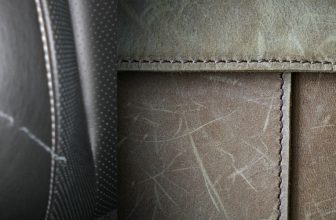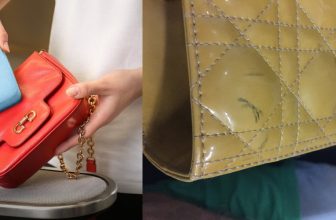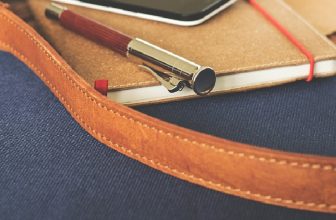How to Stop Leather Dye From Rubbing Off
If you’re like most people, you probably enjoy the look and feel of leather furniture. Not only is it stylish and comfortable, but it lasts a long time. However, if you’ve ever had leather dye rub off onto your clothes or skin, you know that there can be a downside to this type of furniture.
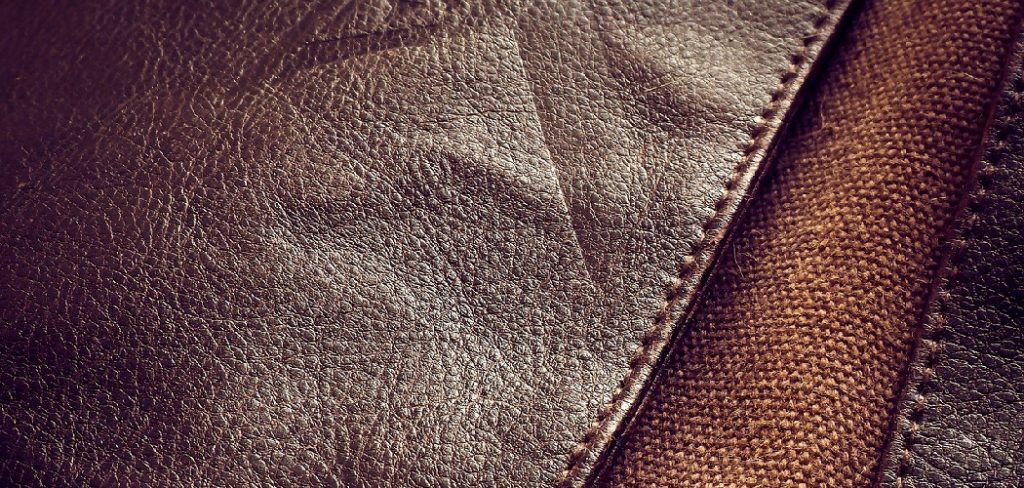
If you have leather seats in your car and dye them a different color, you may notice that the dye is rubbing off on everything else in the car. Fortunately, you can do a few things to help prevent this from happening. In this blog post, we will discuss how to stop leather dye from rubbing off. Keep reading to learn more!
What is Leather Dye?
Before we dive into how to stop leather dye from rubbing off, let’s first understand what leather dye is. Leather dye is a type of pigment or coloring agent used to change the color of leather. It penetrates the surface of the leather and permanently changes its color.
Leather dyes come in a variety of forms, including liquids, gels, and creams. They are commonly used in leather crafting and restoration, as well as for coloring leather furniture, car seats, and other leather goods. However, they can also be the cause of unwanted staining and rubbing off.
10 Reasons That Cause Leather Dye to Rub Off:
1. Alcohol-based Dyes Dry Quickly and Lead to Dye Rub Off:
When the dye, alcohol, and moisture are still in contact with each other, they form a weak bond. This means that as soon as it is rubbed up against it, the dye is easily washed off.

2. Water-based Sealants Cause Water-based Dyes to Rub Off:
Water-based dye forms a weak bond with a water-based sealant, so they easily separate from each other and cause rubbing.
3. Leather Protectant Causes Oil-based Dyes to Rub Off:
The oil-based dye will not form a strong bond with the leather protector, making it easier for these two substances to separate and rub off.
3. Leather Protectant Causes Oil-based Dyes to Rub Off:
This is caused by the dyed area being oversaturated with water-based or oil-based dye, which washes away easily when rubbed up against it. It can also be caused by using too much of the solvent in water-based dyes, causing the dye to seep into the leather rather than coat it.
5. Dyes Are Not Mixed Thoroughly Enough:
This leads to dye components settling out of the solution, which can cause rubbing off if they don’t remain evenly distributed throughout the solution.
6. Dyes Are Not Applied Uniformly Enough:
Rubbing off can occur when dye coats an area unevenly, leaving one part of the leather dyed while another is left undyed. This occurs more frequently on large surfaces, like jackets or sofa cushions.
7. Improper Buffing of Dyed Leather Leads to Rubbing Off:
If excess dye is not removed after the dyeing process, the leather will retain too much moisture, making it rub up easily. The same can happen if buffing is done too quickly or too roughly.
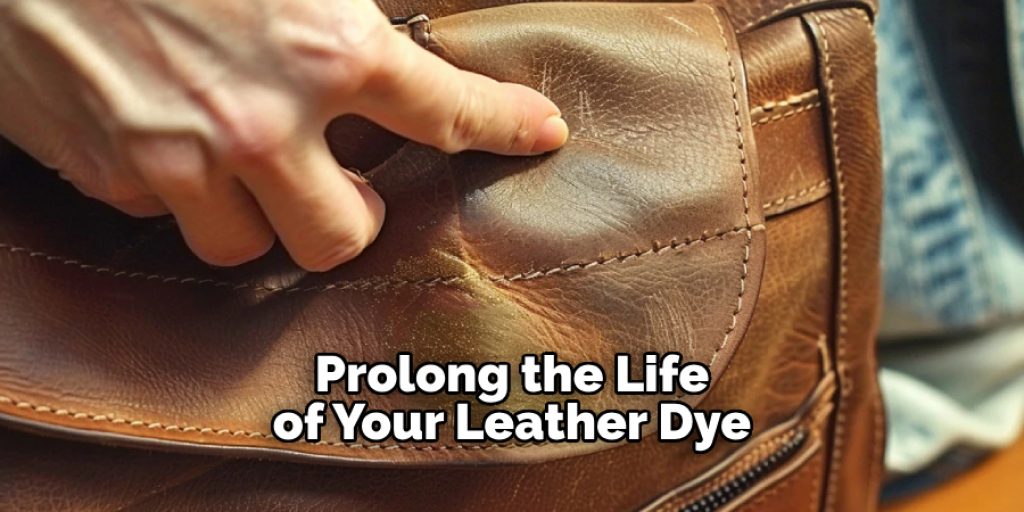
8. Leather Color Fades Over Time:
Leather dyed and left in sunlight for a long time loses its pigment and becomes more transparent. This means that any dye rubbing off the soft leather will be especially visible and take away from the appearance of your leather piece.
9. Most Black Leather Dyes Will Produce Rub Off:
Leathers that are dyed black generally use aniline dyes, which contain large quantities of water-soluble components, making them more likely to rub off.
10. Applying Dye to a Topcoat Sealant Will Lead to Rubbing Off:
Topcoat sealants appear to have good adhesion but contain little or no oil. This means that without penetrating the leather, they are unable to protect it from water-based dye rub-off.
Needed Materials:
Leather Dye (Water-based or Oil-based):
To stop leather dye from rubbing off, you’ll need to have a good, high-quality leather dye on hand. Make sure to choose a dye that is specifically designed for the type of leather you are working with.
Leather Protector:
After dyeing your leather, it’s important to use a sealant or protector to help prevent rubbing off and preserve the color. Choose a protector that is compatible with the type of dye you are using.
Leather Conditioner:
Using a leather conditioner can also help prevent rubbing off. It will keep the leather moisturized and supple, reducing the chances of color transfer. Look for a conditioner made with natural oils and avoid using silicone-based products.
Soft Cloth:
A soft cloth is necessary for applying the dye and buffing the leather. Choose a lint-free cloth to avoid leaving behind any fibers that could get trapped in the dye or sealant.

Gloves:
To protect your skin from coming into contact with the dye, it’s important to wear gloves while working with leather dyes.
8 Effective Ways How to Stop Leather Dye From Rubbing Off:
1. Wipe the Leather With a Damp Cloth:
Before dying, wipe the leather with a damp cloth. It will help remove any loose dirt from the surface and dust particles that may have settled over time on the surface of your leather. Once you have done this, you can go ahead with the dying process without any tension, as this simple step has already done half of the job for you. Once you are done with this step, let the leather dry completely. This will also help remove any moisture that may have been absorbed by the leather.
2. Use a Dye That Has Been Meant Specifically for Leather:
Always use a dye that has been specifically made to die leather. There are many other types of dyes available in the market, but you should avoid them as they can spoil your leather and leave it dull after some time. In order to get the best possible results from the leather dye, you should always use the one that has been made for your specific type of leather. Oil-based dye is perfect for vegetable-tanned leather, while water-based dye is more suitable for chrome-tanned leather.
3. Protect Any Other Parts of the Leather:
After applying any particular colored dye to your desired area, you should protect the leather parts where new dyes might accidentally fall. To avoid this kind of mishap, you should always cover the entire leather with some tape or cloth. In case you are dyeing a large area, then you should cover the entire leather with some cloth or plastic sheet. This will help to prevent any additional dye from getting onto the untreated areas.
4. Apply Color on Specific Areas of Leather:
You do not have to color your whole piece of leather with one unique dye. Instead, you can apply different dyes on various parts of your leather to get a unique look for each area. This way, you can easily make different parts of your leather look different from each other. This is also a great way to mend any old leather item that may have started to dull over time. You can color each part of the leather with different dyes and make it look as good as new. The best part is that you do not need to be a professional to do this.
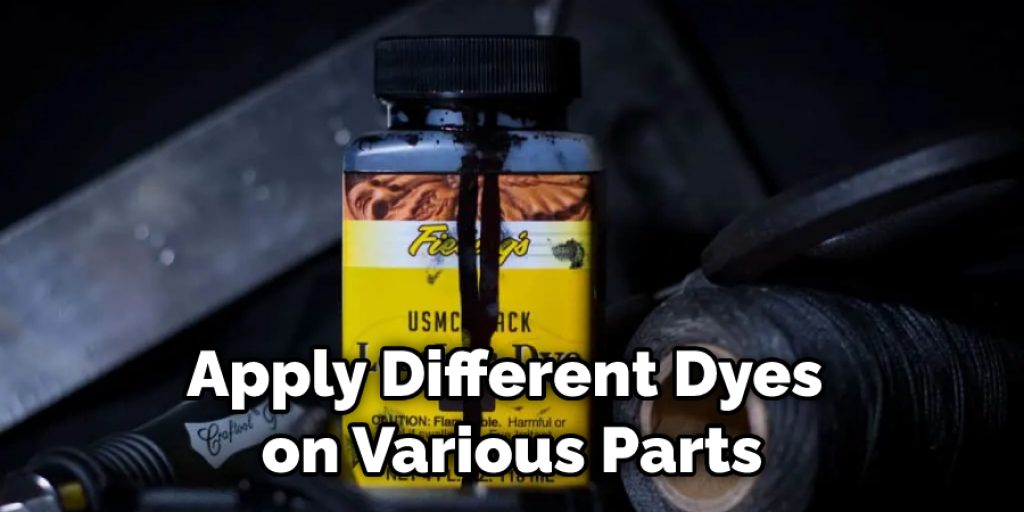
5. Use Paint Brush for Dyeing Leather:
When applying the dye to your leather, you should always use a paintbrush instead of directly dipping your sponge or cloth into the container that has the dye in it several times. If you pick up some dye on your paintbrush, you can easily apply it to the leather without getting the dye all over. This will also help you to control the amount of dye that is being applied, ensuring an even application.
6. Make Sure Your Cloth is Not Damp:
If you want to prevent any rubbing off or smudging of color, then make sure that your cloth is not damp at all when using it to dry your leather. If your cloth is wet, it can easily pick up and remove some of the dye, and you will not be able to get a uniform look for your leather. Instead, use a dry, lint-free cloth to buff the leather after dyeing. The cloth should also be soft enough to avoid any scratches on the leather surface.
7. Use Paste Dye:
You should always use paste dye instead of liquid dye as it will help give you better control over the application process, and you can seal the leather pores with it. This will help you to avoid any rubbing off or smudging of color. Additionally, paste dye is known to give a more even and consistent color compared to liquid dye. You can find paste dye in a wide variety of colors, making it easy to find the perfect shade for your leather. It’s also easier to mix colors to get a custom shade with paste dye.
8. Use Pigment Sealer:
After applying the leather dye to your piece of leather, you should always use some pigment sealer to protect it from coming off. The more you use the pigmented sealer, the better protection your dyed leather will be. This will help to prevent any kind of smudging or rubbing off over time. Make sure to choose a sealer that is compatible with the type of dye you are using. You can also use multiple layers of sealer for added protection. Keep in mind that sealer may slightly alter the shade of your leather dye, so test it on a small, inconspicuous area first before applying it to the entire piece.
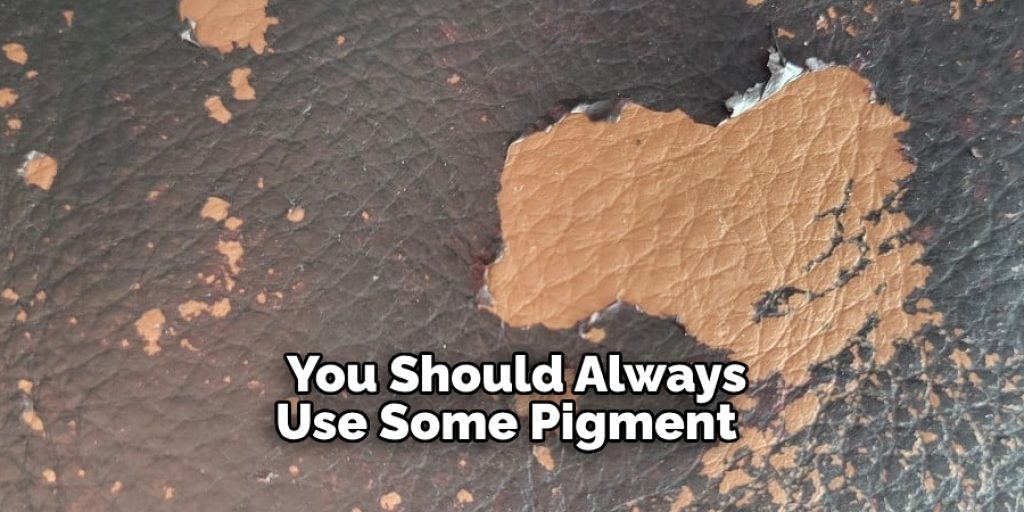
Some Tips and Suggestions:
Here are some tips and suggestions on how to stop leather dye from rubbing off.
1. When you are done dyeing, wash your hands with cold water and dish soap. If there is any dye rubbing on your gloves, this will remove it.
2. If it is on your skin, nothing will remove the dye. Well, nothing short of ruining your garment. Wear gloves or use a brush to apply the coat of dye you want without getting any on yourself.
3. Wash clothes with hot water and cold water in separate loads; always keep dyed items different from other laundry loads until dry.
4. Use a color-catching sheet in your dry cleaning machine to prevent the dye from transferring onto other clothes.
5. If you get dye on another item, immediately spot treat and wash that item separately, then it should be just fine.
6. If it bleeds through, you can use a leather color fixative after the garment is completely dry to seal the color in and keep it from bleeding onto anything else.
7. Remove any stencils before dyeing (or dye them too, and don’t wash over them).
How to Stop Leather from Bleeding Dye?
If your leather product has been dyed, you might be having an issue with the dye rubbing off on other things. Even if the color is still fine, it can still look bad if it rubs off clothes or furniture. However, you can do a few things to stop this from happening.
First, you can give the leather a clear finish to be sealed against water and other liquids. You can also use a wax or pigment dye if your leather is light-colored. These dyes penetrate the leather instead of sitting on top of it. Finally, you can also use a leather spray dye, which is good unless you want to change the entire color of your product.
Once you have finished dying and sealing your product, it’s essential to take care of it after that point so that the dying doesn’t happen again. Be sure not to let anything water-based touch your leather, and try to avoid using it when you know you will be exposed to anything that might rub off onto it.
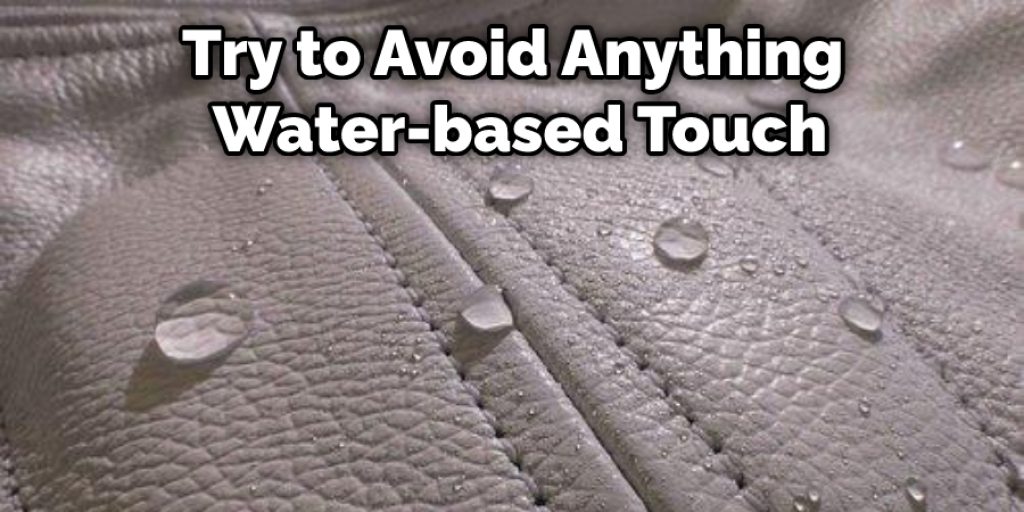
Frequently Asked Questions:
Q: Can I Use Regular Dye on Leather?
A: No, it is not recommended to use regular dye on leather as it can damage the material and leave it dull over time. Always use a dye specifically made for leather. You can find these dyes at craft stores or online. It is worth investing in a high-quality leather dye for the best results.
Q: How Do I Remove Dye From Leather?
A: If you accidentally get dye on your leather product, do not panic. Immediately try to remove the excess dye with a clean cloth or sponge. You can also use a small amount of rubbing alcohol on a cotton pad to gently dab at the stain. If the stain persists, you can try using a leather cleaner or taking it to a professional leather cleaner.
Q: Can I Dye Leather Without Removing the Original Color?
A: Yes, you can dye leather without removing the original color by using a pigment dye. These dyes are designed to penetrate the leather and add color without completely covering up the existing color. However, keep in mind that the new color may not be as vibrant if applied over a darker original color.
Q: How Long Does Leather Dye Last?
A: The longevity of leather dye depends on the quality of the dye and how well it is applied and sealed. With proper application and sealing, leather dye can last for several years without rubbing off or fading. However, keep in mind that leather is a natural material and may still fade with prolonged exposure to sunlight and wear. Regular touch-ups and maintenance can help prolong the life of your leather dye.

Q: Can I Dye Leather Shoes?
A: Yes, you can dye leather shoes as long as they are not made of suede or nubuck. Follow the same steps and tips mentioned above for dyeing leather products to achieve a new color for your shoes. Keep in mind that dyeing may alter the texture and finish of your shoes, so it’s best to test on a small, inconspicuous area first before fully dyeing them.
Conclusion:
To ensure the dye stays put, be careful with how you handle and store your leather goods. Avoid hot water and try not to touch it too much while wearing gloves if possible. If any color does come off onto your hands or clothes, clean them as soon as possible using soap and cold water; do not use detergent or bleach. Remember that dry cleaning is also a great way of preserving the original colors if they get stained by something else!
The best way to avoid the dye from rubbing off is by using a leather conditioner. You can also apply a protectant spray or use a vinyl cover if your sofa is in high-traffic areas. We hope this blog post has helped give you some insights on how to stop leather dye from rubbing off. If you have any questions or want to know more, then feel free to comment below!


